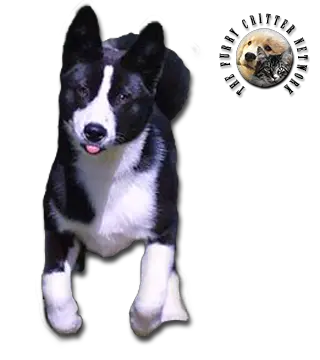Breed Standard
Head: Not heavy. Skull is the shape of an isosceles triangle. Stop not pronounced. Clean muzzle. Tight lips.
Ears: Triangular, carried erect. Mobile. Pointed tips.
Eyes: Not large. Oval. Set obliquely in the skull. Dark color.
Body: Strong. Pronounced withers. Full chest is well let down. Broad, slightly sloped croup. Belly is tucked up. Short, slightly sloped loin. Solid, muscular back.
Tail: Carried in a sickle or curled over the back or the back of the thighs.
Hair:
- Russo-European and Western Siberian Laikas: Hard, straight, short on the head and ears. Longer on the neck, withers, and shoulders. Feathering on the back of the legs. Full undercoat.
- Eastern Siberian Laika: Long, coarse, dense, straight. Male has a mane and collarette. Dense, supple undercoat.
Coat:
- Russo-European Laika: black, gray, white, pepper and salt, dark with white markings or white with dark markings.
- Western Siberian Laika: white, pepper and salt, red and shades of gray; black is permissible.
- Eastern Siberian Laika: pepper and salt, white, gray, black, shades of red or brown; spotted or mottled.
Size:
- Russo-European Laika: dog: 52 to 58 cm (20.5-22.8 in) ; bitch: 50 to 56 cm (19.7-22 in).
- Western Siberian Laika: dog: 54 to 60 cm (21-23.5 in) ; bitch: 52 to 58 cm (20.5-22.8 in).
- Eastern Siberian Laika: dog: 55 to 63 cm (22-25 in) ; bitch: 53 to 61 cm (21-24 in).
Weight: 20 to 30 kg (44-66 lb).
History
When developing the Russo-European Laika, Russian hunters sought out the best working examples of local hunting Laikas from Arkhangelsk, Udmurtia, Karelia, Perm, Ladora Lake, Komi and surrounding regions of north-eastern Russia, all of which appeared to belong to the same breed type, but noticeably different than the Karelian Bear Dog of Finland. By selecting the strongest and healthiest dogs, mainly from the Komi Republic and the district of Pomozda, then crossing them with the old Hanty type of the West-Siberian Laika, the breed developers soon established the appearance, temperament, hunting qualities and overall type of the Russo-European Laika and laid a foundation for the breed.
Behavior
This is a lively breed that enjoys time spent in the great outdoors. As a hunter who frequently trees game, the Russo-European Laika uses its voice to alert the hunter to the treed prey (typically a raccoon or squirrel). The Russo-European Laika is also one of the best dogs for duck hunting. It may use its voice freely in the house as well because it is easily excited about things going on around it. The Russo-European Laika has a strong love of family. Once bonded to them, it is quite territorial and makes an excellent guard dog. It is extremely tolerant of children, although not of strangers or other unfamiliar dogs.
Eager to please and with energy to spare, the Russo-European Laika benefits tremendously from training of any kind. Socialization must begin in puppyhood and continue throughout its life. Obedience classes or participation in a working association will give it a sense of purpose and the frequent exercise it requires. With those opportunities, it will learn quickly and become well balanced as a family dog.
Function
Hunting Dog, Guard Dog, Pet.
Health
Russo-European Laikas are some of the healthiest dogs in the world.






